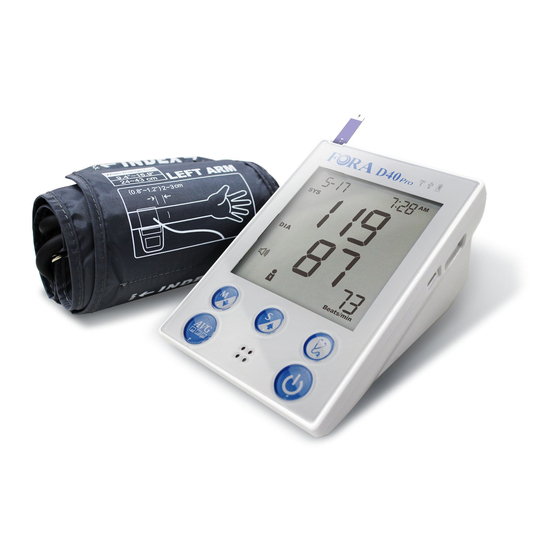
Summarization of Contents
General Blood Pressure Meter Questions
Q1: What are the general features of FORA's blood pressure monitor?
Comprehensive overview of features across FORA blood pressure monitor models, including technology, capacity, and connectivity options.
Q2: How accurate is FORA's Blood Pressure Monitor?
Details FORA's blood pressure monitor accuracy validation against international protocols and acceptable reading tolerances.
Q3: What are the recommended values for blood pressure?
Defines hypertension categories and blood pressure thresholds for office and home measurements as per ESH-ESC guidelines.
Q4: When I take measurements and never get the same reading, is the device inaccurate?
Explains blood pressure variability due to physiological factors and external influences, clarifying that fluctuating readings are normal.
Q5: Are there differences between taking a blood pressure reading on the right arm vs. left arm?
Discusses potential variations in blood pressure readings between the right and left arms and FORA's recommended measurement arm.
Q6: Which pressure is more important about hypertension -- the Systolic or Diastolic blood pressure?
Elucidates the distinct roles and importance of systolic and diastolic blood pressures in assessing hypertension and cardiovascular risk.
Q7: What are the things I need to check for before measuring my blood pressure so as to avoid varied readings?
Lists critical pre-measurement protocols, including lifestyle adjustments and rest periods, to ensure accurate and consistent readings.
Q8: What is the accurate way to fit the cuff?
Provides step-by-step instructions and visual guidance for correctly applying the blood pressure monitor cuff to the upper arm.
Q9: What is the accurate position to measure my blood pressure?
Details the optimal body posture, arm support, and cuff placement relative to the heart for obtaining precise blood pressure measurements.
Q10: What is Auscultatory Mode? Which FORA's Device can use it? Where we can get the direction about using Auscultatory Mode?
Defines the manual Auscultatory Mode, identifies compatible FORA devices, and directs users to relevant sections in the owner's manual.
Q11: What does Oscillometric mode mean?
Explains the automated Oscillometric measurement method used by FORA digital BP monitors to assess blood pressure via arterial vibrations.
Spare Parts – Cuff
Q12: Does the size of the cuff matter? How do I determine the cuff size that I need?
Emphasizes the necessity of selecting the correct cuff size for accurate readings and provides methods for measuring arm circumference.
Q13: What are the cuff sizes?
Lists the available cuff sizes provided with FORA blood pressure monitors, catering to different arm circumferences.
Q14: What is the most common situation when cuff is out of life expectancy?
Identifies common signs of cuff wear, such as air leakage, and error messages indicating the need for cuff replacement.
Q15: What is the average life expectancy of a monitor cuff?
States the typical lifespan of a blood pressure monitor cuff, estimated by usage times and influenced by storage conditions.
Cleaning and Storage
Q16: How do I clean my blood pressure monitor?
Provides clear instructions for cleaning the exterior of the blood pressure monitor and cuff, specifying safe cleaning agents and methods.
Q17: How do I store my blood pressure monitor?
Offers essential guidance on storing the blood pressure monitor, including battery handling, case usage, and environmental considerations.
Common troubleshooting
Q18: Is it normal that my blood pressure is variable?
Confirms that blood pressure naturally fluctuates throughout the day due to lifestyle, activity, and environmental factors.
Q19: What is the international standard of blood pressure?
Details the accuracy validation standards and criteria established by international bodies like ESH, BHS, and AAMI for BP monitors.
Q20: My blood pressure results appear to be abnormal – what should I do?
Advises users to seek immediate consultation with a healthcare professional for diagnosis and management of abnormal blood pressure readings.
Q21: What are the common measuring error reasons?
Lists common error messages, their probable causes (e.g., cuff issues, battery depletion), and recommended solutions for the monitor.






Need help?
Do you have a question about the P30 Plus BT and is the answer not in the manual?
Questions and answers